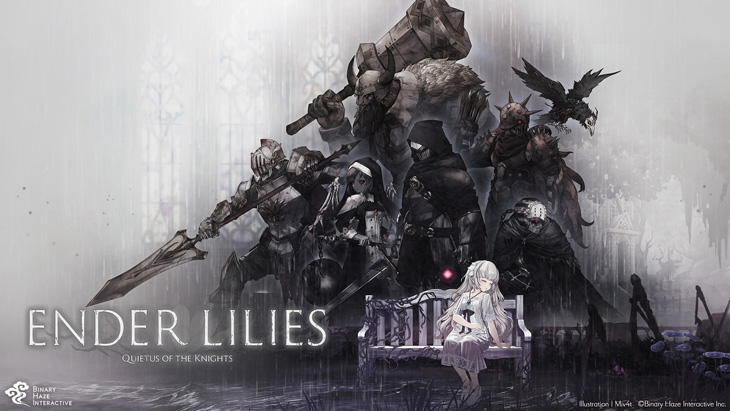
Ender Lilies: Quietus of the Knights is the Dark Souls of Metroidvanias. How’s that for a review? All jokes aside, Ender Lilies borrows heavily from the kind of grimdark aesthetic fans of Dark Souls would appreciate.
The world is covered in grey, and inhabited by long forgotten enemies. Zombielike foes called the “Blighted” roam the ruins of what appears to be a once great kingdom, and it’s up to our heroine Lily to save it… Or at least stop it from getting worse than it is.
So the comparisons to Dark Souls are largely skindeep, but frankly as a fan of the grimdark aesthetic popularized by games like it Darkest Dungeon, I couldn’t be happier. But can Ender Lilies: Quietus of the Knights stand out in the Metroidvania genre? Especially with Nintendo themselves getting back into the game after so long?
ENDER LILIES: Quietus of the Knights
Developer: Live Wire, Adglobe
Platforms: Windows PC (reviewed), Nintendo Switch, PlayStation 5, Xbox One, Xbox Series X|S
Release Date: June 21, 2021
Players: 1
Price: $24.99 USD

Ender Lilies: Quietus of the Knights begins with our protagonist: the titular Lily. After awaking from some sort of long slumber, she’s greeted by an apparition. The “Umbral Knight” becomes her sword against the threat posed by the Blighted.
Which brings us to one of the game’s more interesting points, Lily herself doesn’t fight directly. She’s the one putting her life on the line and dodging, but every attack is the action of a spirit accompanying Lily, acting as her sword, hammer, flail, and more.
Lily’s introduction and the Umbral Knight are the only plot points really given asides from a short opening cinematic. The fate of the kingdom and perhaps the world are left for the player to discover as they play. Notes and little excerpts are hidden throughout the map (though the more important ones are put in plain sight).
Learning the story of Ender Lilies is in a way its greatest reward, much like Dark Souls (I swear I’ll stop comparing them after this). The lack of frontloaded exposition makes the world feel mysterious, and every strange thing just makes sense.
Players will find themselves asking questions about the nature of the Blight; but the beautiful aesthetics and the pace of storytelling will maintain suspension of disbelief even without handholdy exposition.
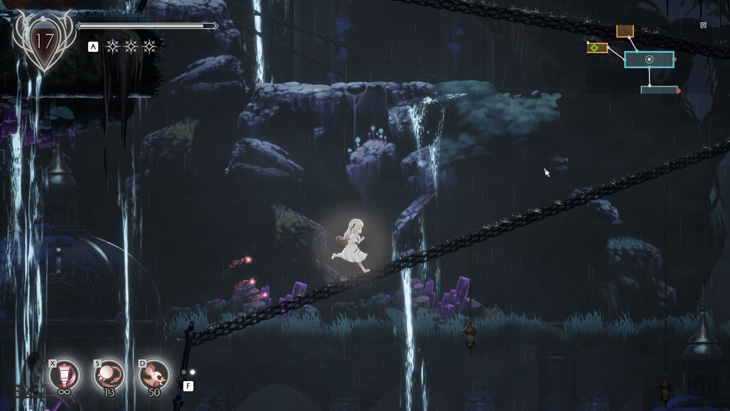
So with the story left for the player to discover for themselves (and ultimately reach one of the game’s multiple endings), the aesthetics and graphics are the game’s main draw; the thing that will really suck players into a feeling of investment. Ender Lilies does not disappoint on this front.
Animations are fluid, and character design is slightly cartoony in terms of proportions, but that only serves to enhance the more grotesque details of enemies. Mushroom people with pale flesh stretched over bulbous bodies, legless aberrations that crawl and pounce with jagged bone erupting from their tattered flesh; every enemy is designed to contrast with Lily’s own wholesome appearance.
Equal attention is given to the stages and ambiance. No detail is forgotten, and depth is provided for every zone. Whether it’s the darkened halls of the White Parish, or the forests of the Witch’s Thicket. Some of the animations might be a little stiff, but honestly it helps with the telegraphing of attacks, so it’s a forgivable issue.
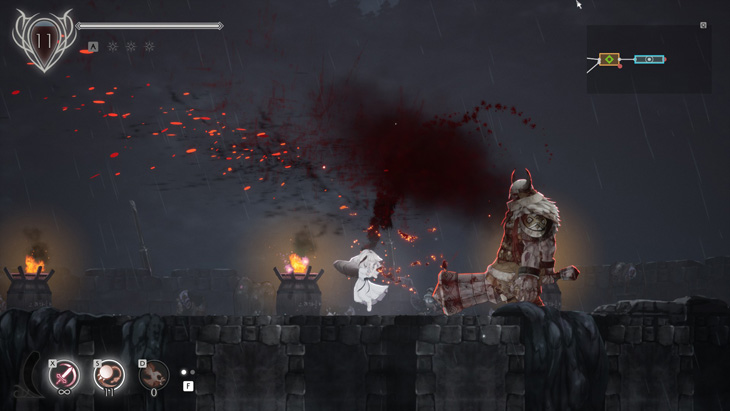
Gameplay is a little deeper than classic Metroidvanias, in the sense that you can dodge and change your attacks wholesale. Lily has two spirit sets that she can swap between at any time. The Umbral Knight is a constant companion with unlimited uses and is Lily’s basic attack, though later in the game there’s a different spirit that’s also limitless in use.
Most of the other spirits will unfortunately have restricted use, and are only able to attack a certain number of times before needing to be replenished. This can be done at a rest point (basically a save location), or by attacking red blooms that exist in some zones.
These extra attacks largely exist to give Lily ranged options, or to provide defensive coverage. One early spirit spawns a flail-wielding woman who stays on the spot for a couple seconds, which can be used to attack vicious enemies while Lily safely hops over them.
Some ranged enemies will stand on narrow platforms, and necessitate the use of ranged weapons in turn (or take damage simply jumping at them, swinging, and then landing in blighted water). Different spirits have their uses, but the game never really makes you feel like you’ll be stuck if you expend all your limited use spirits.
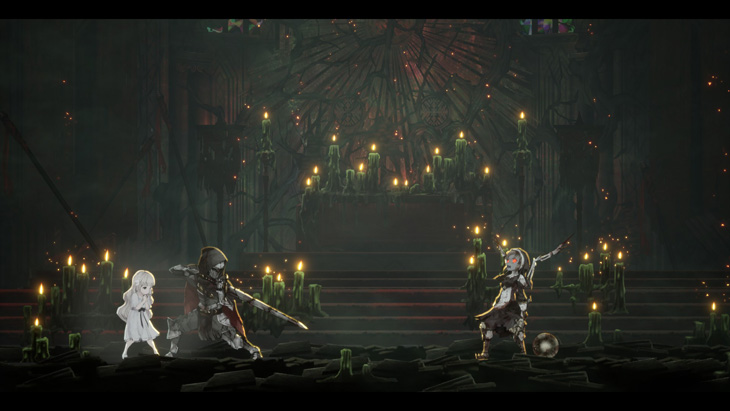
The enemies are challenging, but thankfully losing is no great setback. There’s usually a rest point before most bosses, so it’s easy to get back in the fight after taking a few attempts to learn their attacks.
Stage design leaves a little to be desired. There’s definitely a lot to explore, but there are a few minor issues. For instance one zone in the Witch’s Thicket has a door blocking the way, forcing Lily to take the long way around as a challenge. A switch just inside the door will open it. With the right positioning, it’s incredibly simple to just reach through the door with an attack and skip most of the zone.
Asides from small issues like that, there’s the issue of backtracking. I understand it’s a staple of the genre, but when the game doesn’t even give a hint to what mechanics will appear, you find yourself ignoring things that seem difficult, and have to trust the game will give you a means later.
There’s no indication that defeating the first boss unlocks double jumping, and there’s no clue that these scab-like floor barriers will need to be broken with a ground pounding spirit you receive later. Worse still, you may spend time trying to finesse spirits to use on objects such as the scab before realizing you simply need a tool you don’t have yet.
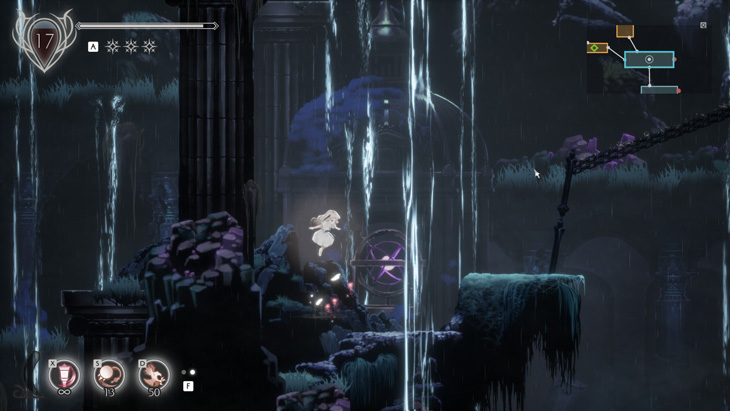
Ender Lilies does take some of the sting away from backtracking by allowing fast travel between rest points. Even so, it still means that you’ll probably want to do a complete walkthrough of the entire game once you’ve unlocked everything if you’re a completionist.
The music in Ender Lilies is absolutely fantastic. The OST was composed by Project Mili, a Japanese group whose work has appeared in the otome game Backstage Pass, the animated film Goblin Slayer: Goblin’s Crown, and more. Each song evokes a haunting feeling that perfectly suits the aesthetic of the game, as players control the frail Lily while she wades through the blighted wreckage of a once peaceful kingdom.
Ultimately, Ender Lilies: Quietus of the Knights is a fantastic fantasy story wrapped up in an action-packed platformer. Fans of environmental storytelling and mystery will find a lot to love in this game, alongside the action platformer fans waiting for yet another Metroidvania to conquer.
Players will find themselves enamored with the game’s grimdark aesthetic and art direction; and while there may be some hiccups with the stage design or some frustration with the combat, Ender Lilies is a welcome addition to the Metroidvania genre that is likely to satisfy a broad swathe of gamers.
Ender Lilies: Quietus of the Knights was reviewed on Windows PC using a code provided by Binary Haze Interactive. You can find additional information about Niche Gamer’s review/ethics policy here.